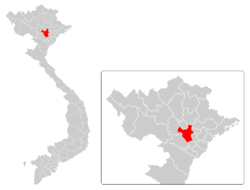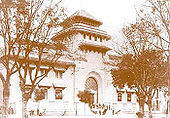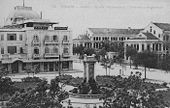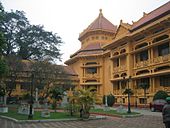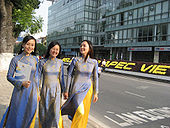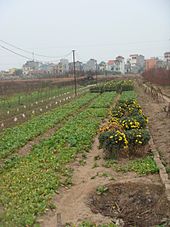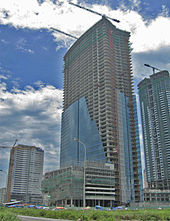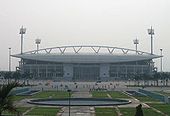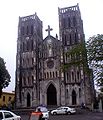- Hanoi
-
Hanoi
Thành phố Hà Nội— Centrally governed city — Clockwise from top: Turtle Tower in Hoan Kiem Lake, in central Hanoi; Ho Chi Minh Mausoleum; Hanoi Opera House; sunset over the Red River from Long Bien Bridge; Temple of Literature; One Pillar Pagoda 
Emblem of HanoiProvincial location in Vietnam Coordinates: 21°2′0″N 105°51′00″E / 21.033333°N 105.85°ECoordinates: 21°2′0″N 105°51′00″E / 21.033333°N 105.85°E Country  Vietnam
VietnamCentral city Hanoi Founded, Capital of the Đại Việt 1010 Capital of Vietnam September 2, 1945 Demonym Hanoians[1] Government – Party's Secretary (Bí thư Thành ủy) Phạm Quang Nghị – People's Council's President (Chủ tịch Hội đồng Nhân Dân) Ngô Thị Doãn Thanh – People's Committee's President (Chủ tịch Ủy ban Nhân Dân) Nguyễn Thế Thảo Area – Centrally governed city 3,344.7 km2 (1,291.4 sq mi) – Urban 186.22 km2 (71.9 sq mi) Population (2009) – Centrally governed city 6,500,000 – Rank 2nd in Vietnam – Density 1,943.4/km2 (5,033.3/sq mi) Time zone ICT (UTC+7) Website hanoi.gov.vn Hanoi (Vietnamese: Hà Nội,
 listen), is the capital of Vietnam and the country's second largest city. Its population in 2009 was estimated at 2.6 million for urban districts,[2] 6.5 million for the metropolitan jurisdiction.[3] From 1010 until 1802, it was the most important political centre of Vietnam. It was eclipsed by Huế during the Nguyen dynasty as the capital of Vietnam, but Hanoi served as the capital of French Indochina from 1902 to 1954. From 1954 to 1976, it was the capital of North Vietnam.
listen), is the capital of Vietnam and the country's second largest city. Its population in 2009 was estimated at 2.6 million for urban districts,[2] 6.5 million for the metropolitan jurisdiction.[3] From 1010 until 1802, it was the most important political centre of Vietnam. It was eclipsed by Huế during the Nguyen dynasty as the capital of Vietnam, but Hanoi served as the capital of French Indochina from 1902 to 1954. From 1954 to 1976, it was the capital of North Vietnam.The city is located on the right bank of the Red River. Hanoi is located at 1,760 km (1,090 mi) north of Ho Chi Minh City.
October 2010 officially marked 1000 years since the establishment of the city. On this occasion, Hanoi was named by Frommer's travel guide as one of the world's "Top Destinations 2010".[4]
Contents
History
-
Turtle Tower in Hoan Kiem Lake, in central Hanoi
-
Emperor Lý Thái Tổ made Thăng Long (Hanoi) his capital in the 11th century
Hanoi has been inhabited since at least 3000 BC. One of the first known permanent settlements is the Co Loa citadel (Cổ Loa) founded around 200 BC.
Hanoi has had many names throughout history, all of them of Sino-Vietnamese origin. During the Chinese domination of Vietnam, it was known first as Long Biên, then Tống Bình (Chinese: 宋平, Sòngpíng, "Song Peace") and Long Đỗ (Chinese: 龍肚, Lóngdù, "Dragonbelly"). In 866, it was turned into a citadel and named Đại La (Chinese: 大羅, Dàluó, "Big Net").
In 1010, Ly Thai To, the first ruler of the Lý Dynasty, moved the capital of Đại Việt to the site of the Đại La Citadel. Claiming to have seen a dragon ascending the Red River, he renamed the site Thăng Long (昇龍, "Rising Dragon") - a name still used poetically to this day. Thăng Long remained the capital of Đại Việt until 1397, when it was moved to Thanh Hóa, then known as Tây Đô (西都), the "Western Capital". Thăng Long then became Đông Đô (東都), the "Eastern Capital."
In 1408, the Chinese Ming Dynasty attacked and occupied Vietnam, changing Đông Đô's name to "Eastern Gateway" (Chinese: 東關, Dōngguān), Đông Quan in Vietnamese. In 1428, the Vietnamese overthrew the Chinese under the leadership of Lê Lợi, who later founded the Lê Dynasty and renamed Đông Quan Đông Kinh (東京, "Eastern Capital") or Tonkin. Right after the end of the Tây Sơn Dynasty, it was named Bắc Thành (北城, "Northern Citadel").
In 1802, when the Nguyễn Dynasty was established and moved the capital to Huế, the old name Thăng Long was modified to become Thăng Long (昇隆, "Ascending & Flourishing"). In 1831, the Nguyễn emperor Minh Mạng renamed it Hà Nội (河内, "Between Rivers" or "River Interior"). Hanoi was occupied by the French in 1873 and passed to them ten years later. As Hanoï, it became the capital of French Indochina after 1887.
The city was occupied by the Japanese in 1940 and liberated in 1945, when it briefly became the seat of the Viet Minh government after Ho Chi Minh proclaimed the independence of Vietnam. However, the French returned and reoccupied the city in 1946. After nine years of fighting between the French and Viet Minh forces, Hanoi became the capital of an independent North Vietnam in 1954.
During the Vietnam War, Hanoi's transportation facilities were disrupted by the bombing of bridges and railways. These were all, however, promptly repaired. Following the end of the war, Hanoi became the capital of a reunified Vietnam when North and South Vietnam were reunited on July 2, 1976.
On May 29, 2008, it was decided that Ha Tay Province, Vĩnh Phúc's Mê Linh district and 4 communes of Lương Sơn District, Hoa Binh be merged into the metropolitan area of Hanoi from August 1, 2008.[5] Hanoi's total area then increased to 334,470 hectares in 29 subdivisions[6] with the new population being 6,232,940.[6], effectively tripling its size. The Hanoi Capital Region (Vùng Thủ đô Hà Nội), a metropolitan area covering Hanoi and 6 surrounding provinces under its administration, will have an area of 13,436 square kilometers with a population of 15 million by 2020.[7]
Climate
Hanoi features a warm humid subtropical climate (Köppen Cwa) with plentiful precipitation. The city experiences the typical climate of northern Vietnam, where summers are hot and humid, and winters are, by national standards, relatively cool and dry. Summers, lasting from May to September, are hot and humid, receiving the majority of the annual 1,680 millimetres (66.1 in) of rainfall. The winters are short, relatively dry, and mild, while spring can bring light rains.
Climate data for Hanoi (1898-2011) Month Jan Feb Mar Apr May Jun Jul Aug Sep Oct Nov Dec Year Record high °C (°F) 33
(91)34
(93)37
(99)39
(102)43
(109)40
(104)40
(104)38
(100)37
(99)36
(97)36
(97)37
(99)43
(109)Average high °C (°F) 19.3
(66.7)19.9
(67.8)22.8
(73.0)27.0
(80.6)31.5
(88.7)32.6
(90.7)32.9
(91.2)31.9
(89.4)30.9
(87.6)28.6
(83.5)25.2
(77.4)21.8
(71.2)27.0 Daily mean °C (°F) 16.4
(61.5)17.0
(62.6)20.2
(68.4)23.7
(74.7)27.3
(81.1)28.8
(83.8)28.9
(84.0)28.2
(82.8)27.2
(81.0)24.9
(76.8)21.4
(70.5)18.2
(64.8)23.5 Average low °C (°F) 13.7
(56.7)15.0
(59.0)18.1
(64.6)21.4
(70.5)24.3
(75.7)25.8
(78.4)26.1
(79.0)25.7
(78.3)24.7
(76.5)21.9
(71.4)18.5
(65.3)15.3
(59.5)20.9 Record low °C (°F) 3
(37)6
(43)7
(45)10
(50)16
(61)21
(70)22
(72)21
(70)17
(63)14
(57)7
(45)5
(41)3
(37)Rainfall mm (inches) 18.6
(0.732)26.2
(1.031)43.8
(1.724)90.1
(3.547)188.5
(7.421)239.9
(9.445)288.2
(11.346)318.0
(12.52)265.4
(10.449)130.7
(5.146)43.4
(1.709)23.4
(0.921)1,676.2
(65.992)% humidity 78 82 83 83 77 78 79 82 79 75 74 75 78.8 Avg. rainy days 8.4 11.3 15.0 13.3 14.2 14.7 15.7 16.7 13.7 9.0 6.5 6.0 144.5 Sunshine hours 93 56 62 120 186 180 186 186 180 155 150 124 1,678 Source no. 1: World Meteorological Organisation (UN) [8] Source no. 2: World Climate Guide [9] Education
Hanoi, as the capital of French Indochina, was home to the first Western-style universities in Indochina, including: Indochina Medical College (1902) - now Hanoi Medical University, Indochina University (1904) - now Hanoi National University, and École Supérieure des Beaux-Arts de L'Indochine (1925) - now Hanoi University of Fine Art.
After the Communist Party took control over Hanoi in 1954 with support from the Soviet Union, many new universities were built, among them, Hanoi University of Technology remains the largest technical university in Vietnam.
Hanoi is the largest centre of education in Vietnam. It is estimated that 62% of the scientists in the whole country are living and working in Hanoi.[10] Admissions to undergraduate study are through entrance examinations, which are conducted annually and open for everyone (who has successfully completed his/her secondary education) in the country. The majority of universities in Hanoi are public, although in recent years a number of private universities have started their operation. Thăng Long University, founded in 1988, by some Vietnamese mathematics professors in Hanoi and France[11] is the first private university in Vietnam.
Because many of Vietnam's major universities are located in Hanoi, students from other provinces (especially in the northern part of the country) wishing to enter university often travel to Hanoi for the annual entrance examination. Such events often take place in June and July, during which a large number of students and their families converge on the city for several weeks around this intense examination period. In recent years, these entrance exams have been centrally coordinated by the Ministry of Education, but passing marks are decided independently by each university.
Although there are state owned kindergartens, there are also many private ventures that serve both local and international needs. Pre-tertiary (elementary and secondary) schools in Hanoi are generally state run although there are some independent schools. Education is equivalent to the K–12 system in the US, with elementary school between grades 1 and 5, middle school (or junior high) between grades 6 and 9, and high school from grades 10 to 12.
Landmarks
As the capital of Vietnam for almost a thousand years, Hanoi is considered one of the main cultural centres of Vietnam, where most Vietnamese dynasties have left their imprint. Even though some relics have not survived through wars and time, the city still has many interesting cultural and historic monuments for visitors and residents alike. Even when the nation's capital moved to Huế under the Nguyễn Dynasty in 1802, the city of Hanoi continued to flourish, especially after the French took control in 1888 and modeled the city's architecture to their tastes, lending an important aesthetic to the city's rich stylistic heritage. The city hosts more cultural sites than any city in Vietnam,[12] and boasts more than 1,000 years of history, and that of the past few hundred years has been well preserved.[13]
Old Quarter
The Old Quarter, near Hoan Kiem lake, has the original street layout and architecture of old Hanoi. At the beginning of the 20th century the city consisted of only about 36 streets, most of which are now part of the old quarter. Each street then had merchants and households specialized in a particular trade, such as silk traders, jewellery, etc. The street names nowadays still reflect these specializations, although few of them remain exclusively in their original commerce. The area is famous for its small artisans and merchants, including many silk shops. Local cuisine specialties as well as several clubs and bars can be found here also. A night market (near Đồng Xuân market) in the heart of the district opens for business every Friday, Saturday, and Sunday evening with a variety of clothing, souvenirs and food.
Some others prominent places are: The Temple of Literature (Văn Miếu), site of the oldest university in Vietnam 1010; One Pillar Pagoda (Chùa Một Cột); Flag Tower of Hanoi (Cột cờ Hà Nội). In 2004, a massive part of the 900 year old Hanoi Citadel was discovered in central Hanoi, near the site of Ba Dinh Square.[14]
Lakes
A city between the rivers, built from lowland, Hanoi has many scenic lakes and sometime is called "city of lakes". Among its lakes, the most famous are Hoan Kiem Lake, West Lake, Halais Lake (Hồ Thiền Quang in Vietnamese), and Bay Mau Lake. Hoan Kiem Lake, also known as Sword Lake, is the historical and cultural center of Hanoi, and is linked to the legend of the magic sword. West Lake (Hồ Tây) is a popular place for people to spend time. It is the largest lake in Hanoi and there are many temples in the area. There are small boats for hire and a floating restaurant.
Colonial Hanoi
Under French rule, as an administrative centre for the French colony of Indochina, the French colonial architecture style became dominant, many examples remain today: the tree-lined boulevards (e.g. Phan Dinh Phung street) and its many villas and mansions, Grand Opera House, State Bank of Vietnam (formerly The Bank of Indochina), Presidential Palace (formerly Palace of the Governor-General of French Indochina), Saint Joseph Cathedral, and the historic Hotel Metropole. Many of the colonial structures are an eclectic mixture of French and traditional Vietnamese architectural styles, such as the National Museum of Vietnamese History, the Vietnam National Museum of Fine Arts and the old Indochina Medical College.
Museums
Hanoi is also home to a number of museums:
- National Museum of Vietnamese History
- Vietnam National Museum of Fine Arts
- Vietnam Museum of Ethnology
- Vietnam Museum of Revolution
- Hanoi Hilton (Hoa Lo Prison)
- Ho Chi Minh Museum
- Contemporary Arts Centre
- Vietnam Military History Museum
- The Hanoi Museum (currently under construction until 2010)
Entertainment
A variety of options for entertainment in Hanoi can be found throughout the city. Modern and traditional theaters, cinemas, karaoke bars, dance clubs, bowling alleys, and an abundance of opportunities for shopping provide leisure activity for both locals and tourists. Hanoi has been named as one of the top 10 cities for shopping in Asia by Smart Travel Asia.[15] The number of art galleries exhibiting Vietnamese art has dramatically increased in recent years, including galleries such as "Nhat Huy" of Huynh Thong Nhat.
A popular traditional form of entertainment is water puppetry, which is shown for example at the Thăng Long Water Puppet Theatre.
Shopping
With its rapid growth and extremely high population density, several modern shopping centers have been built in Hanoi. Major centers include:
- Trang Tien Plaza, Hoan Kiem District
- Vincom City Towers, Ba Trieu Street, Hai Ba Trung District
- Ruby Plaza, 44 Le Ngoc Han Street, Hai Ba Trung District
- Parkson Department Store, Tây Sơn Street, Viet Tower, Dong Da District
- Big C Thăng Long Supercenter, Cau Giay District
- Metro AG, Tu Liem District
- The Garden Mall, Me Tri - My Dinh, Tu Liem District
- Vincom Shopping Galleries, Vincom Park Place, Hai Ba Trung District
- Ciputra Mall, Ciputra urban area, Tay Ho District (currently under construction)
- Yen So Shopping Mall, Hoang Mai District (currently under construction)
Voluntary work
Hanoi Free Tour Guides (http://hanoifreetourguides.com/) is a social non-profit organization founded and run by a group of students and ex-students since January 2010 aiming at propagandizing and publicly introducing the images of Vietnam, its country and people to foreigners, promoting cross-cultural communication and building up a bridge for the enhancement of international relations for the betterment of the society.
Cuisine
Hanoi has rich food traditions and many of Vietnam's most famous dishes, such as phở, chả cá, bánh cuốn and cốm are thought to come from Hanoi. Perhaps most widely known is Phở, a simple rice noodle soup often eaten as a breakfast dish in the home or at streetside cafes, but also served in restaurants as a meal. Two varieties dominate the Hanoi scene: Phở Bò, containing beef, and Phở Gà, containing chicken.
Hanoi has been selected as one of the top 10 cities for food in the world by Shermans Travel.[16] Vietnam's national dish Phở has been also named as one of the Top5 streetfood in the world by globalpost.[17]
Hanoi has a restaurant about the insect food, in Khuong Thuong village, Hanoi. The most special cuisines at his restaurant are those processed from ant-eggs, in the styles of Thai people or Muong and Tay ethnic people in Vietnam.
Population
Hanoi's population is constantly growing (about 3.5% per year[18]), a reflection of the fact that the city is both a major metropolitan area of Northern Vietnam, and also the country's political centre. This population growth also puts a lot of pressure onto the infrastructure, some of which is antiquated and dates back from the early 20th century.
The number of Hanoians who settled down for more than three generations is likely to be very small as compared to the overall population of the city. Even in the Old Quarter, where commerce started hundreds years ago and was mostly a family business, many of the street-front stores nowadays are owned by merchants and retailers from other provinces. The original owner family may have either rented out the store and moved to live further inside the house, or just moved out of the neighbourhood altogether. The pace of change has especially escalated after the abandonment of central-planning economic policies, and relaxing of the district-based household registrar system.[citation needed]
Hanoi's telephone numbers have been increased to 8 digits to cope with demand (October 2008). Subscribers telephone numbers have been changed in a haphazard way.
Transport
Hanoi is served by Noi Bai International Airport, located in the Soc Son District, approximately 40 km (25 mi) north of Hanoi. Noi Bai is the only international airport for the northern regions of Vietnam.
Hanoi will have additionally another international airport, which will cost $8 billion, being the highest foreign investment so far in the history of Vietnam.[19] The construction will be carried out in three stages,the first phase will start in 2011 until 2015.
There are two main highways linking the airport and city. The route to the city via Thăng Long Bridge is more direct than Highway 1, which runs along the outskirts of the city. The main highways are shared by cars, motor scooters, with separate lanes by the side for bicycles. Taxis are plentiful and usually have trip meters, although it is also common to agree on the trip price before taking a taxi from airport to the city centre. Tourists also sometimes tour the city on cyclos especially in the Old Quarter.
Hanoi is also the origin departure point for many Vietnam Railways train routes in the country. The Reunification Express (tàu Thống Nhất) runs from Hanoi to Ho Chi Minh City from Hanoi station (formerly Hang Co station), with stops at cities and provinces along the line. Trains also depart Hanoi frequently for Hai Phong and other northern cities.
The main means of transport within the city are motorbikes, buses, taxis, and bicycles. Motorbikes remain the most common way to move around the city.[citation needed] Public buses run on many routes and fare can be purchased on the bus. For short trips, "xe ôm" (literally, "hug vehicle") motorcycle taxis are available where the passenger sits at the rear of a motorbike.
Economy
Hanoi has the highest Human Development Index among the cities in Vietnam.[citation needed] According to a recent ranking by PricewaterhouseCoopers, Hanoi will be the fastest growing city in the world in term of GDP growth from 2008 to 2025.[20]
Industrial production in the city has experienced a rapid boom since the 1990s, with average annual growth of 19.1 percent from 1991–95, 15.9 percent from 1996–2000, and 20.9 percent during 2001–2003.[citation needed] In addition to eight existing industrial parks, Hanoi is building five new large-scale industrial parks and 16 small- and medium-sized industrial clusters. The non-state economic sector is expanding fast, with more than 48,000 businesses currently operating under the Enterprise Law (as of 3/2007).[21]
Trade is another strong sector of the city. In 2003, Hanoi had 2,000 businesses engaged in foreign trade, having established ties with 161 countries and territories. The city's export value grew by an average 11.6 percent each year from 1996–2000 and 9.1 percent during 2001–2003.[citation needed] The economic structure also underwent important shifts, with tourism, finance, and banking now playing an increasingly important role.
Hanoi's business districts are traditionally Hoan Kiem and the neighborhood; and a newly developing Trung Hoa Nhan Chinh in the southwestern part.
Similar to Ho Chi Minh City, Hanoi enjoys a rapidly developing real estate market.[22] The metropolis's economy growth does not seem correlative to its infrastructure. Overloading population requires a much larger supply of accommodations, while the constructing celerities of both transport system and new urban areas are too low.[23] Not surprisingly, as an effect of this problem, the apartment and real estate fever occur severely during the time.[24] More widespread, the fever even influences Ha Tay, the neighboring province, considered the future development space of the capital.[25] The current most notable new urban areas are central Trung Hoa Nhan Chinh, My Dinh, the luxurious zones of The Manor and Ciputra.
Agriculture, previously a pillar in Hanoi's economy, has striven to reform itself, introducing new high-yield plant varieties and livestock, and applying modern farming techniques.[citation needed]
Together with economic growth, Hanoi's appearance has also changed significantly, especially in recent years. Infrastructure is constantly being upgraded, with new roads and an improved public transportation system.[citation needed]
Sport centers
There are several gymnasiums and stadiums throughout the city of Ha Noi. The biggest ones are My Dinh National Stadium (Le Duc Tho Boulevard), Quan Ngua Sporting Palace (Van Cao Avenue), Hanoi Water Sport Complex and My Dinh Indoor Athletics Gymnasium. The others include Ha Noi stadium (as known as Hang Day stadium). The third Asian Indoor Games was held at Hanoi in 2009.
Health care and other facilities
Some medical facilities in Hanoi:
- Bach Mai Hospital
- Viet Duc Hospital
- Saint Paul Hospital
- 108 Hospital
- L'Hôpital Français De Hanoï
- International SOS
Districts
Hanoi is divided into 10 inner districts, 1 town and 18 outer districts.[26] ( Hà Đông has been transform to an inner district, and Sơn Tây has been degraded to a town)
Subdivisions of Hanoi Provincial Cities/Districts[26] Wards[26] Area (km2)[26] Population[26] 1 town Sơn Tây 15 113.474 181,831 10 Urban Districts (Quận) Ba Đình 14 9.224 228,352 Cầu Giấy 8 12.04 147,000 Đống Đa 21 9.96 352,000 Hai Bà Trưng 20 14.6 378,000 Hà Đông 17 47.917 198,687 Hoàn Kiếm 18 5.29 178,073 Hoàng Mai 14 41.04 216,277 Long Biên 14 60.38 170,706 Tây Hồ (West Lake) 8 24 115,163 Thanh Xuân 11 9.11 185,000 Subtotal 145 233.56 2,178,258 18 Rural Districts (Huyện) Ba Vì 31 + 1 town 428.0 242,600 (1999) Chương Mỹ 30 + 2 towns 232.9 261,000 (1999) Đan Phượng 15 + 1 town 76.8 124,900 Đông Anh 23 + 1 town 182.3 276,750 Gia Lâm 20 + 2 towns 114.0 205,275 Hoài Đức 19 + 1 town 95.3 188,800 Mê Linh 16 + 2 towns 141.26 187,536 (2008) Mỹ Đức 21 + 1 town 230.0 167,700 (1999) Phú Xuyên 26 + 2 towns 171.1 181,500 Phúc Thọ 25 + 1 town 113.2 154,800 (2001) Quốc Oai 20 + 1 town 136.0 (2001) 146,700 (2001) Sóc Sơn 25 + 1 town 306.51 254,000 Thạch Thất 22 + 1 town 128.1 149,000 (2003) Thanh Oai 20 + 1 town 129.6 142,600 (1999) Thanh Trì (Green Ponds) 15 + 1 town 98.22 241,000 Thường Tín 28 + 1 town 127.7 208,000 Từ Liêm 15 + 1 town 75.32 240,000 Ứng Hòa 28 + 1 town 183.72 193,731 (2005) Subtotal 399 + 22 towns 3,266.186 3,872,851 Total 559 + 22 towns 3,344.47 6,232,940 International relations
Twin towns — Sister cities
Hanoi is twinned with:
 Hong Kong
Hong Kong Ankara, Turkey
Ankara, Turkey Warsaw, Poland[27]
Warsaw, Poland[27] Toulouse, France
Toulouse, France Bangkok, Thailand
Bangkok, Thailand Fukuoka Prefecture, Japan
Fukuoka Prefecture, Japan Moscow, Russia[28]
Moscow, Russia[28] Beijing, People's Republic of China
Beijing, People's Republic of China Manila, Philippines
Manila, Philippines Seoul, South Korea
Seoul, South Korea Phnom Penh, Cambodia[29]
Phnom Penh, Cambodia[29] Jakarta, Indonesia,(Start Since August 2011)
Jakarta, Indonesia,(Start Since August 2011) Isfahan, Iran,(Start Since 4 August 2011)
Isfahan, Iran,(Start Since 4 August 2011)
Gallery
-
Presidential Palace, Hanoi (formerly Place of The Governor-General of French Indochina)
-
Vietnam National Convention Center on Pham Hung Boulevard
See also
- Gioi Market
- Ho Chi Minh City
- List of historical capitals of Vietnam
References
- ^ www.cnngo.com/sydney/visit/sexual-frustrations-single-white-female-hanoi-170958
- ^ General Statítcs Office ò Vietnam
- ^ "Vietnam's Population Soars". balita.ph. http://balita.ph/2009/08/15/vietnams-population-soars-to-85-8-million/.
- ^ "Frommer's Top Destinations 2010". Frommers.com. http://www.frommers.com/articles/6469.html.
- ^ "Country files (GNS)". National Geospatial-Intelligence Agency. http://earth-info.nga.mil/gns/html/cntry_files.html. Retrieved 2007-04-06.
- ^ a b "Hơn 90% đại biểu Quốc hội tán thành mở rộng Hà Nội". Dantri. http://dantri.com.vn/Sukien/Hon-90-dai-bieu-Quoc-hoi-tan-thanh-mo-rong-Ha-oi/2008/5/234655.vip. Retrieved 2008-05-29.
- ^ "VietNamNet - Vùng Thủ đô Hà Nội sẽ rộng 13.436km2, gồm 8 tỉnh, TP", vietnamnet.vn.
- ^ "World Weather Information Service - Hanoi". Hydro-Meteorological Service of Vietnam. http://worldweather.wmo.int/082/c00308.htm. Retrieved 2010-06-24.
- ^ "Hanoi Climate Guide". http://www.worldclimateguide.co.uk/climateguides/vietnam/hanoi.php.
- ^ "Hanoi - The capital of Vietnam: Preface". Hanoi City People's Committee. http://www.hanoi.gov.vn/hanoiwebs/en/hanoi_capital/group1/index.htm.
- ^ Viet Nam News (1998-04-09). "Viet Nam News". Vietnamnews.vnagency.com.vn. http://vietnamnews.vnagency.com.vn/showarticle.php?num=01INN290106. Retrieved 2010-06-18.
- ^ "The quick look at Hanoi". Vietnam National Administration of Tourism. http://www.vietnamtourism.com/e_pages/country/province.asp?mt=844&uid=71.
- ^ "Introduction to Hanoi". The New York Times from Frommer's. November 20, 2006. http://travel.nytimes.com/frommers/travel/guides/asia/vietnam/hanoi/frm_hanoi_0197010001.html. Retrieved May 4, 2010.
- ^ Pinkowski, Jennifer (October 16, 2007). "Thăng Long the ancient city underneath Hanoi". New York Times. http://www.nytimes.com/2007/10/16/science/16dig.html?_r=1&ref=world&oref=slogin. Retrieved 2007-10-22.
- ^ "Detailed results and winners of the online Smart Travel Asia Best in Travel Poll 2009". Smarttravelasia.com. http://www.smarttravelasia.com/travelpoll.htm. Retrieved 2010-06-18.
- ^ Top 10 Cities for Foodies[dead link]
- ^ "Best Street Food | Vietnamese Pho | Peruvian Food". Globalpost.com. http://www.globalpost.com/dispatch/food/100114/best-street-food-vendors. Retrieved 2010-06-18.
- ^ VIETNAMNET, Ha Noi, Viet nam. "VietNamNet - Census reports Hanoi population at 3.4 million". English.vietnamnet.vn. http://english.vietnamnet.vn/social/2008/01/765257/. Retrieved 2010-06-18.[dead link]
- ^ Asia Pulse (2010-01-21). "Article » Spain'S Garuda Group To Build Three Airports In Vietnam". AirportBusiness.com. http://www.airportbusiness.com/online/article.jsp?siteSection=1&id=33784&pageNum=3. Retrieved 2010-06-18.
- ^ "Hanoi and Ho Chi Minh City are topping the world's highest economic growth cities in 2008-2025". PricewaterhouseCoopers. 2009-11-10. http://www.bbgv.org/download/businessnewsfiles/december/2009_11_10_PwC_Hanoi%20&%20HCMC_top%20positions_economic%20growth_08-25_Final_EN_.pdf.
- ^ "'Tram hoa' doanh nghiep dua no". VnExpress. http://vnexpress.net/Vietnam/Kinh-doanh/2007/04/3B9F5334/.
- ^ "NLĐO - Bat dong san Ha Noi soi dong ~ Bất động sản Hà Nội sôi động - KINH TẾ - TIÊU DÙNG". http://www.nld.com.vn/tintuc/kinh-te/215457.asp.
- ^ "Hà Nội: Cải tạo, xây dựng chung cư cũ còn rất chậm". vietbao.vn. http://vietbao.vn/Van-hoa/Ha-Noi-Cai-tao-xay-dung-chung-cu-cu-con-rat-cham/45218635/505/.
- ^ "VTC News - Thị trường nhà đất Hà Nội lên cơn sốt mới". http://vtc.vn/kinhdoanh/nhadat/165821/index.htm.
- ^ "Hà Nội: "Hội chứng sốt" đất phía tây! - Ha Noi: "Hoi chung sot" dat phia tay!". LAODONG.COM.VN. http://www.laodong.com.vn/Home/kinhte/2008/1/73165.laodong.
- ^ a b c d e "Cổng giao tiếp điện tử Thành Phố Hà Nội". Hanoi.gov.vn. 2009-06-26. http://www.hanoi.gov.vn/. Retrieved 2010-06-18.
- ^ "Miasta partnerskie Warszawy - Strona 4". um.warszawa.pl. Biuro Promocji Miasta. 2005-05-04. http://www.um.warszawa.pl/node/2920?page=0,3. Retrieved 2011-06-17.
- ^ "Hanoi Days in Moscow help sister cities". http://www.vnbusinessnews.com/2008/07/hanoi-days-in-moscow-helps-sister.html.
- ^ [1]
External links
- Official Site of Hanoi Government
- An article in New York Times about Hanoi
- NewHanoian.com - Community information with user-created content, interactive maps, and reviews
- Hanoi travel guide from Wikitravel

Vinh Phuc province Thai Nguyen province Bac Giang province 
Phu Tho province 
Bac Ninh province  Hanoi
Hanoi 

Hoa Binh province Ha Nam province Hung Yen province  Hanoi
HanoiUrban districts: Provincial towns: Rural districts: Ba Vi · Chuong My · Dan Phuong · Dong Anh · Gia Lam · Hoai Duc · Me Linh · My Duc · Phu Xuyen · Phuc Tho · Quoc Oai · Soc Son · Thach That · Thanh Oai · Thanh Tri · Thuong Tin · Tu Liem · Ung HoaSubdivisions of Vietnam Regions Municipalities Can Tho · Da Nang · Hai Phong · Hanoi · Ho Chi Minh City
Provinces An Giang · Bac Giang · Bac Kan · Bac Lieu · Bac Ninh · Ba Ria-Vung Tau · Ben Tre · Binh Dinh · Binh Duong · Binh Phuoc · Binh Thuan · Ca Mau · Cao Bang · Dak Lak · Dak Nong · Dien Bien · Dong Nai · Dong Thap · Gia Lai · Ha Giang · Ha Nam · Ha Tinh · Hai Duong · Hoa Binh · Hau Giang · Hung Yen · Khanh Hoa · Kien Giang · Kon Tum · Lai Chau · Lam Dong · Lang Son · Lao Cai · Long An · Nam Dinh · Nghe An · Ninh Binh · Ninh Thuan · Phu Tho · Phu Yen · Quang Binh · Quang Nam · Quang Ngai · Quang Ninh · Quang Tri · Soc Trang · Son La · Tay Ninh · Thai Binh · Thai Nguyen · Thanh Hoa · Thua Thien-Huế · Tien Giang · Tra Vinh · Tuyen Quang · Vinh Long · Vinh Phuc · Yen Bai
 Cities in Vietnam
Cities in Vietnam 
Centrally-controlled cities Special-classHanoi • Ho Chi Minh1st-classProvincial cities 1st-class2nd-class3rd-classBac Lieu • Bac Giang • Bac Ninh • Bao Loc • Ben Tre • Cao Lanh • Cam Ranh • Dong Ha • Dong Hoi • Dien Bien Phu • Ha Tinh • Hoa Binh • Hoi An • Hung Yen • Kon Tum • Lang Son • Lao Cai • Mong Cai • Ninh Binh • Phan Rang-Thap Cham • Phu Ly • Quang Ngai • Rach Gia • Soc Trang • Son La • Tam Ky • Tan An • Thai Binh • Tra Vinh • Tuy Hoa • Tuyen Quang • Vi Thanh • Vinh Long • Vinh Yen • Yen BaiCategories:- Capitals in Asia
- Populated places in Hanoi
- District capitals in Vietnam
- Hanoi
- Red River Delta
- 1010 establishments
- Populated places established in the 11th century
- Port cities in Vietnam
- Cities in Vietnam
-
Wikimedia Foundation. 2010.


